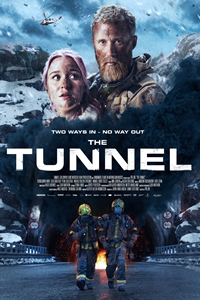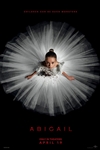The Tunnel (Tunnelen) () ★★★
 Two of the most enjoyable disaster films I have seen in the past half-dozen years have emerged not from the powerhouse studios in Hollywood but from Norway. The first was the 2015 tsunami movie, The Wave, and the second was released in 2019 (but, having been delayed by the real-life disaster of COVID-19, took about 18 months to reach U.S. theaters) with the title The Tunnel. Lacking the special effects budgets of American disaster films - a condition that invariably results in scripts so dumbed-down that a rutabaga could follow them - the Norwegian variants do the best they can with the visuals (which are better than adequate) and focus instead on things like character development and narrative momentum. No, these aren't Shakespearean masterpieces, but they are surprisingly effective for genre material.
Two of the most enjoyable disaster films I have seen in the past half-dozen years have emerged not from the powerhouse studios in Hollywood but from Norway. The first was the 2015 tsunami movie, The Wave, and the second was released in 2019 (but, having been delayed by the real-life disaster of COVID-19, took about 18 months to reach U.S. theaters) with the title The Tunnel. Lacking the special effects budgets of American disaster films - a condition that invariably results in scripts so dumbed-down that a rutabaga could follow them - the Norwegian variants do the best they can with the visuals (which are better than adequate) and focus instead on things like character development and narrative momentum. No, these aren't Shakespearean masterpieces, but they are surprisingly effective for genre material.
The movie opens with an introductory "informational" caption that explains the prevalence and importance of tunnels in Norway. After that, the overall story follows the typical disaster movie playbook: the first act introduces the characters and ends with the event, the second act follows the efforts of various characters to survive the event and its aftermath, and the third act provides a heroic resolution. Disaster movies that deviate from this formula are few and far between and The Tunnel isn't an exception.
Stein (Thorbjorn Harr) is a veteran road crew worker who is getting ready to celebrate Christmas with his girlfriend, Ingrid (Lisa Carlehed), and daughter, Elise (Ylva Lyng Fuglerud). There's tension between the two women because Elise believes her father has moved on too fast following the death of her mother and is unwilling to accept his relationship with Ingrid. Following an argument, Elise boards a bus headed out of town. The bus is in the tunnel when a tanker truck crashes, blocking all traffic. A subsequent explosion fills the tunnel with black, toxic smoke that is detrimental to breathing and impossible to see through. With the main rescue team on the far side of the tunnel stymied from being able to help due to an avalanche, Stein and his crew leap into action. But the smoke, coupled with a lack of cameras in the tunnel, make it unclear what the situation is on the inside. Stein is cautious until he learns that his daughter is involved.
If the premise sounds familiar, that's because this isn't the first time the basic idea has been used as the foundation of a film. Back in 1996, Sylvester Stallone headlined Daylight, which postulated that a nasty crash inside the Holland Tunnel had cataclysmic results, collapsing both ends and trapping a small group of scrappy survivors inside. When it came to effects, Daylights was all flash. When it came to the screenplay, it was all fizzle. The Tunnel's approach, like its story, is less ostentatious, less focused on mixing an adrenaline cocktail, and more balanced. Replacing the "wow!" factor of Daylight's big explosion, The Tunnel instead opts to provide us with characters we learn to care about in a more grounded (and therefore suspenseful) situation.
The key to The Tunnel's success is that the filmmakers respect the characters, treating them as more than two-dimensional pawns. The concept of a "character-based disaster film" isn't as much of an oxymoron as it might seem to be. Although it's easy to assume that the key aspects of any such endeavor are the special effects, believable characters are essential to establishing and maintaining suspense - otherwise, it's just an orgy of disaster porn money shots. Director Pal Oie and screenwriter Kjersti Helen Rasmussen understand this basic tenet of moviemaking.
The Tunnel has its share of imperfections. There are times when it hews too closely to the disaster movie template, resulting in a degree of predictability that undercuts suspense. There's also a disconnected subplot about a group of people who (for one reason or another) escape the disaster and are holed up in a nearby inn. This material, which is neither well-written nor well-acted, feels like filler.
Although it might seem odd to call a disaster film "low-key," the label applies in this case. That shouldn't be interpreted as a criticism. There are times when a less-is-more approach results in gripping entertainment and The Tunnel is one such example.
© 2021 James Berardinelli
To get the full Quicklook Films experience, uncheck "Enable on this Site" from Adblock Plus
box office top 10

The Fall Guy Released: May 3, 2024 Cast: Ryan Gosling, Emily Blunt 28.5M

Star Wars Episode 1 The Phantom Menace 25th Anniversary Released: May 3, 2024 Cast: Ewan McGregor, Liam Neeson 8.1M

Challengers Released: April 26, 2024 Cast: Zendaya, Josh O'Connor 7.6M

Tarot Released: May 3, 2024 Cast: Harriet Slater, Adain Bradley 6.5M

Godzilla x Kong: The New Empire Released: March 29, 2024 Cast: Rebecca Hall, Brian Tyree Henry 4.5M

Civil War Released: April 12, 2024 Cast: Kirsten Dunst, Wagner Moura 3.6M

Unsung Hero Released: April 26, 2024 Cast: Daisy Betts, Joel Smallbone 3M

Kung Fu Panda 4 Released: March 8, 2024 Cast: Jack Black, Awkwafina 2.4M

Abigail Released: April 19, 2024 Cast: Melissa Barrera, Dan Stevens 2.3M

Ghostbusters: Frozen Empire Released: March 22, 2024 Cast: Paul Rudd, Carrie Coon 1.8M






